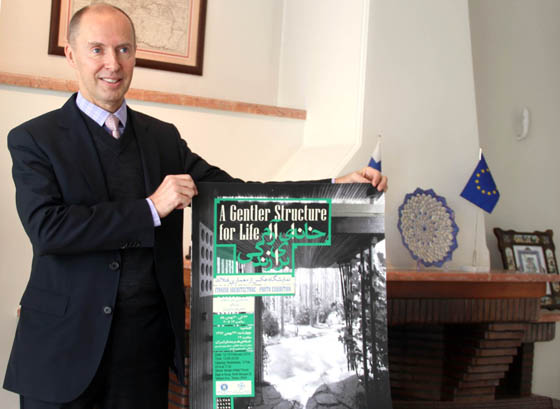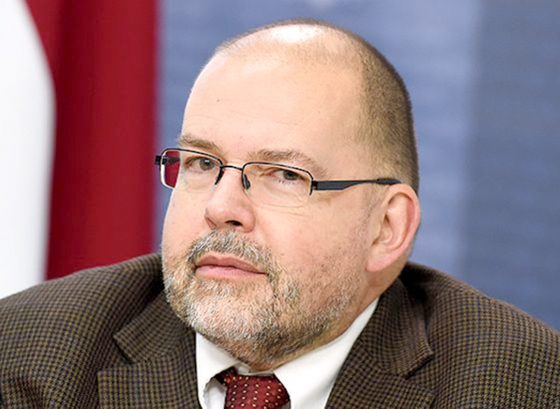“We Aim at Expanding Our Cultural Ties with Iran”, Says the Ambassador

Following the Photography Exhibition held by the embassy of Finland at Iranian Artists Forum and the participation of Holma Maija, a Finnish well-recognized figure in photography, Ava Diplomatic held an interview with Harri Kämärainen, the ambassador of Finland in Tehran, delving deeper into the mutual cultural ties from different angles.
Exclusive Interview of Ava Diplomatic with the Ambassador of Finland
Interview by Mohammadreza Nazari
Well, let’s begin the interview with an interesting point; you are one of the professional directors of the Ministry of Foreign Affairs of Finland, and have started your diplomatic tenure since 1987. What was the reason you chose diplomacy as an area of your interests?
I was already at school interested in international relations and different countries and cultures. After joining the Finnish Foreign Service in 1987, I served my first years at the International Trade Department of the Ministry in a unit which was in charge of Finland´s trade relations with Eastern European countries.
Ever since then, my work has within regular intervals taken me to that region. Before coming to Iran, I worked in Helsinki as the Director of the Unit for Eastern Europe and Central Asia. In that capacity I had the pleasure to visit the countries in the South Caucasus – Armenia, Azerbaijan and Georgia- and the five Central Asian countries – Kazakhstan, Kyrgyzstan, Tajikistan, Turkmenistan and Uzbekistan – on several occasions. I saw how ancient Persia and Iran have been present in those regions. There is a lot of common history and culture between Iran and its Northern and North Eastern neighbours. That´s why I became more and more interested in the history and politics of Iran.
After coming to Iran, you made many plans for cultural activities to expand ties between Finland and Iran, including your photography-architecture exhibition named “A Gentler Structure for Life”. What are the objectives of holding such an exhibition?
Indeed, on 12 February 2014 we opened the first exhibition on Finnish Architecture and Design in the Islamic Republic of Iran. I believe that culture, art, literature, music but also architecture and industrial design can help us understand each other. I wanted to open a small window for the Iranian audience into the Finnish life and also bring our experts to Tehran to meet with their Iranian colleagues. But, actually, the idea of organizing this exhibition was a joint idea between Iran and Finland.
Why do you think we chose architecture? From the very first moment of my arrival in Iran, what interested me was that Iran has always had great architects and designers. Iran and ancient Persia have given a lot to the Western civilization, particularly in terms of architecture, mathematics, geometry and design.
Finland is also a country of world famous architects – one of the best known of whom is Alvar Aalto. He is already well known among architects in Iran, but I wanted to introduce his works also the broader public – and not only his buildings, but also his furniture and interior design. Aalto even had a project for Shiraz and he visited Iran before his death. But, unfortunately, the project was never materialized. Aalto has had a great impact on many architects around the world.
There is also another aspect that connects Finland with Iran, and it is the love and respect for nature. This attitude can also very clearly be seen in the works of Aalto.
But with this exhibition I do not want to look only into the past, but also look into the future. Finland is one of the leading countries in the world, what comes to energy efficiency and environmentally clean technologies. Perhaps we may be able to increase our cooperation with Iran also in these fields.
As you know, Finland has a very severe climate so the Finnish architects and engineers have to build houses which are energy-efficient. The technology we use has been designed to preserve energy and to protect the environment. I believe these are issues that are of importance also for the citizens of Iran.
You just mentioned an interesting point. In 2011 you requested to be in Iran as Ambassador, which was accepted in 2012. Were you quite familiar with Iran’s potentials in culture and civilization?
Before coming here, I knew Iran was a country with a long and rich history, great civilization and bountiful culture. But what I did not know was that already the Iranian architects have inspired the history by their creativity. For example, I can refer to “Baadgirs” as the first air conditioning systems, “Aab-anbars” – places to store the water and traditional Iranian “Ice houses” which were environmentally efficient and ecological. To me they represent ancient ecological architecture. In fact, they gave us so great insights that even today, our architects find them interesting and discuss and study them.
For example, Alvar Aalto´s idea about indirect light follows the same principle as the “baadgirs” in ancient Iranian houses. Meanwhile, I feel that there are many more interesting features for our experts to explore and discuss.
Will you also discuss architecture at your photography exhibition in Tehran?
In connection with the exhibition we organized a seminar on modern Finnish Architecture, which was well attended and well received. Professor Anssi Joutsiniemi from Tampere University and photographer Maija Holma from the Alvar Aalto Museum in Jyväskylä participated at our Seminar.
At the upcoming exhibition, besides architecture, we also exhibit some achievements in the field of industrial design from Finland.
As a continuation to this week of Finnish Culture in Tehran we will organize an evening with Finnish music – Sibelius and the Music of Finland – which will take place on 10 Esfand. Next year will be the anniversary year of the greatest Finnish composer, Sibelius, but in Tehran we decided to start this celeberation already a bit in advance.
How many photographers will come to Iran to take part in the exhibition?
This exhibition is a joint collaboration between Iranian Artists´ Forum and Finland’s Aalto Museum and two Iranian architects – Doctor Ranjbar and Ms. Motalaei. The photographer of Aalto Museum, Ms. Maija Holma, who compiled the Finnish part of the exhibition, will be present for the opening.
The idea of this exhibition is to present two views on Finnish architecture and urban planning: the Iranian view on one part and the Finnish view on the other part. I hope it will be an interesting event for the Iranian audience.
I read your article of October 31, 2013 on Iran’s economic and industrial potentials. There, you pointed to the operation of Finnish textile machineries in Iran, and that in Iran, there is a great lot of demands for automation motors. That is why I was hoping we could see some pictures of Finland’s textile industry at this exhibition. In fact, an industrial exhibition is not a simple event. It can be an introduction to Finland’s industry. Do you have any plans for an exhibition of industrial photography in Iran?
Actually, what we see in this exhibition is some outstanding products of Finnish textile industry – mainly textiles for interior design. These are fabrics that you will find in absolutely every Finnish home. That is also the reason why the exhibition is called A Gentler Structure for Life (Khane-ye Aram baraye Zendegi).
But again, if we speak about industrial production there is an important aspect to keep in mind – namely the environmentally clean technologies. This is a leading theme in Finnish industry and also Finnish life style.
Finding solutions to help preserve the environment is a matter of importance not only for the Finnish and the Iranians but for the whole world.
At the moment, Finland is working on a project named “Beautiful Beijing” in China which is a contribution to help fight the air pollution in Beijing.
What is actually the objective of “Beautiful Beijing”?
One of the objectives is to increase the level of energy efficiency and to implement clean technologies in every day life in order to improve the quality of air.
Tehran is also suffering from air pollution. Why do you not help Tehran?
Our cooperation with China in this field has only started and am sure once we will see the results of this cooperation, we remain open to any suggestions.
Sanctions are now barring the countries from working with Iran. Do you not find them disturbing in offering your services to Iran?
Currently there is an interim agreement between E3+3 and Iran and some of the sanctions have been lifted for a period of half a year. The negotiations on a final agreement will start on Februrary 18. We do hope that the talks would produce desired results and a final agreement could be reached. I wish the best of luck to the negotiating teams.
Sweden seems to be outpacing Finland to seize the opportunities, because its FM is now having words with Mr. Zarif.
Finland´s Foreign Minister Erkki Tuomioja has met with the Foreign Minister of the Islamic Republic of Iran, Doctor Zarif, on a few occasions – recently on 31 January this year.
But it happened in Munich, not in Tehran. We hope that one day Tehran can host the FM of Finland.
The Munich conference offers an excellent opportunity also for bilateral meetings.
We hope Finland will be as effective and active in other areas as it is now in culture.
The reason I am talking about culture is the current exhibition. But it does not mean our embassy is not active in other fields. Another area which I wish to promote is the contacts between students and universities.
Absolutely. Why is there no university professor at the photography exhibition?
Ms. Maija Holma who compiled the exhibition comes from Alvar Aalto –museum and she is renowned photographer in Finland. Ms. Holma has been working for the Aalto museum for 20 years. Also, we have one of the famous architect professors from the University of Tampere, Mr. Anssi Joutsiniemi, participating at the Seminar and the Exhibition.
Have you planned to fix an occasion for them to deliver a lecture at Tehran or Art Universities?
We have planned to have a seminar, named “Urban Planning and Modern Architecture of Finland”, at Iranian Artists´ Forum as well as different activities at the University in Tehran.
Due to the great wealth of your activities, was it now better to have a week of Finland’s culture in Tehran?
This was only a small event, but perhaps a good beginning.




